Vittorio Storaro is one of the best cinematographers of all time. We can admire his magnificent use of light in film that will remain in our memories, like Apocalypse Now, Last tango in Paris, 900, Dick Tracy and, The Last Emperor. In the latter, his studies and experiments with colours as a mean to communicate emotions reach a high grade of expressive maturity that powerfully enhances the already magnificent cinematography of the film. As you all know, the film deals with the last emperor of China, from his birth till he becomes just another worker of the People's Republic of China, it is an introspective story of the Emperor. According to Storaro, every particular colour is not only a bridge with a particular emotion but light and colour make react body and mind in different ways (daylight is associated with activity, for example, while night is with reflection); colours can also be associated with a particular age of our life, so he decided to separate the different ages of the Emperor chromatically, lighting with different tone of lights accordingly to the age and mood. But he didn't limit himself to just play with hues, he also created contrast with colours (as he already did in Apocalypse now) and played with the colour of objects in scenes using what in literature is called anaphora, a repetition of the same colour, in our case, to emphasize a concept.
In The Last Emperor's first scene we see a group of prisoners arriving to a station and waiting for being transferred to a prison. The Emperor is among them. The scene is quite dark, in a grey tone, with practically no colour. Grey is an undefined colour; it represents the waiting, the reflection, the preparation for a new journey, for the start of a new life. All the scenes in which the Emperor is in jail are in grey.
 While at the station, the Emperor try to commit suicide, which is itself a symbol of death and rebirth, and we see the first colour: the red of the blood. The following scene opens with big red doors opening; the baby emperor is taken away from her mother; all this scenes have red tones. Red is the first colour of the chromatic scale. It symbolizes the birth, the vital impulse, the start of every thing (later, when the emperor gets married, red will be the predominant colour in objects in the scene). In the first scene it also symbolizes, of course, Communism and its effects on the Emperor
While at the station, the Emperor try to commit suicide, which is itself a symbol of death and rebirth, and we see the first colour: the red of the blood. The following scene opens with big red doors opening; the baby emperor is taken away from her mother; all this scenes have red tones. Red is the first colour of the chromatic scale. It symbolizes the birth, the vital impulse, the start of every thing (later, when the emperor gets married, red will be the predominant colour in objects in the scene). In the first scene it also symbolizes, of course, Communism and its effects on the Emperor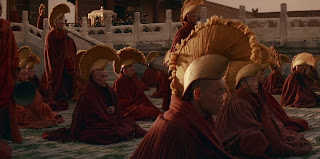 The second colour is orange. It is associated with the range of age between 5 and 8 years; it leads us into the life, it is the warmth of the family, the domestic colour. In the scenes with orange tone, Pu Yi arrives to the Forbidden City, to his new family.
The second colour is orange. It is associated with the range of age between 5 and 8 years; it leads us into the life, it is the warmth of the family, the domestic colour. In the scenes with orange tone, Pu Yi arrives to the Forbidden City, to his new family.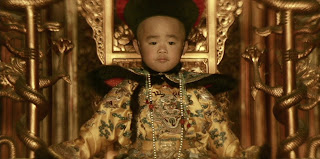 Pu Yi is still a child when he becomes emperor: the tone of the scene becomes yellow. Yellow can be associated to 10 to 15 years of age; it is the colour of puberty, it's intuition and awareness. It is the colour of light, it symbolizes the sun, the divine and its presence, it's the colour of the empire. Storaro uses it throughout the film not only as a tone but even placing in the scene objects of this colour, like the scene of the little emperor playing with the yellow banner which lifts up revealing the courtyard of the Forbidden City full of eunuchs: the rise of the emperor above his subjects.
Pu Yi is still a child when he becomes emperor: the tone of the scene becomes yellow. Yellow can be associated to 10 to 15 years of age; it is the colour of puberty, it's intuition and awareness. It is the colour of light, it symbolizes the sun, the divine and its presence, it's the colour of the empire. Storaro uses it throughout the film not only as a tone but even placing in the scene objects of this colour, like the scene of the little emperor playing with the yellow banner which lifts up revealing the courtyard of the Forbidden City full of eunuchs: the rise of the emperor above his subjects.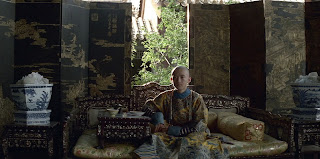 Till this moment the chromatic world of the film is quite poor: red, orange and yellow, alternated with the grey of the scenes of the prisons. Pu Yi has been living in the Forbidden City, ignoring the world outside it; when he starts to acknowledge the existence of that world, the chromatic scale expands along with this knowledge. This change is represented by green, the colour of spring, of the nature that flourishes, of life that starts again. It represents the age around the 20 years, the study, the knowledge that takes us to freedom. It is brought with the introduction of the British tutor and the green bicycle he gave the emperor as a present.
Till this moment the chromatic world of the film is quite poor: red, orange and yellow, alternated with the grey of the scenes of the prisons. Pu Yi has been living in the Forbidden City, ignoring the world outside it; when he starts to acknowledge the existence of that world, the chromatic scale expands along with this knowledge. This change is represented by green, the colour of spring, of the nature that flourishes, of life that starts again. It represents the age around the 20 years, the study, the knowledge that takes us to freedom. It is brought with the introduction of the British tutor and the green bicycle he gave the emperor as a present.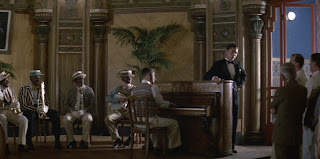 The centre of our life is represented by blue. It is the colour of freedom, perspicacity of thinking, the intellect; while red is the past and green the present, blue is the colour of the future. It is the complementary of yellow: while the latter represents the sun, blue is associated with the moon. The tone of the scenes changes into blue when the Emperor leaves the Forbidden City for the first time, exiled by communist: he always wanted to leave his "prison", his limited world but never could because they wouldn't let him. The exile is his freedom.
The centre of our life is represented by blue. It is the colour of freedom, perspicacity of thinking, the intellect; while red is the past and green the present, blue is the colour of the future. It is the complementary of yellow: while the latter represents the sun, blue is associated with the moon. The tone of the scenes changes into blue when the Emperor leaves the Forbidden City for the first time, exiled by communist: he always wanted to leave his "prison", his limited world but never could because they wouldn't let him. The exile is his freedom.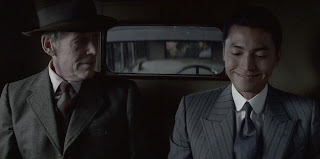 When Pu Yi realizes he want to be again the Emperor of China, the tone of the images becomes indigo. It is the colour associated to the age around 50. Indigo represents full maturity, material power, the achievement of a level of life, a new balance between reason and passion.
When Pu Yi realizes he want to be again the Emperor of China, the tone of the images becomes indigo. It is the colour associated to the age around 50. Indigo represents full maturity, material power, the achievement of a level of life, a new balance between reason and passion.
During the years Pu Yi is held in prison, the Chinese Government tries to re-educate him to communism. The tone of the scene shot in the prison is always been grey but, as soon has Pu Yi starts to accept his responsibility a violet tone appears. Violet is the full balance between passion and reason, is the diffusion of knowledge, it represents the cyclic nature of life and the age between 70 and 80.
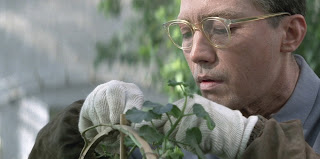 White is the sum of all the colours, therefore it is the sum of all the ages, of all the phases, feelings and passions. It is life as one, the union and the completeness of it and it is associated with the last years of life. The pure white appears for the first time with snow, when Pu Yi earns his freedom and gets out from jail as a free citizen of the People's Republic of China. He returns to the Forbidden City but this time the image is balanced, with no prevailing tone.
White is the sum of all the colours, therefore it is the sum of all the ages, of all the phases, feelings and passions. It is life as one, the union and the completeness of it and it is associated with the last years of life. The pure white appears for the first time with snow, when Pu Yi earns his freedom and gets out from jail as a free citizen of the People's Republic of China. He returns to the Forbidden City but this time the image is balanced, with no prevailing tone.
Throughout the film there's one more colour which is always present: black. It is the matrix, the matter, the birth of elements. It is the beginning and the end, the presence and the absence of something and, of course, the unconscious.
The Last Emperor is not only an example of great cinematography by Storaro, it is the demonstration that philosophy, psychology, history, painting and every kind of art go hand by hand with cinematography to achieve a creative and unique way to visually tell a story, it is a must-see film for every cinematographer, Dp or photographer who wants to improve his art.









Good article.... keep-up the good work.... May I share a blog about Beijing, at Forbidden City in https://stenote.blogspot.com/2018/10/beijing-at-forbidden-city.html
ReplyDeleteWatch also the video in youtube https://youtu.be/mFRbH9breNk
Hey, nice site you have here! Keep up the excellent work!
ReplyDeleteData Centre Lighting
Lighting Audit
I find Storaro's use of color in The Last Emperor to be incredibly effective and moving.
ReplyDelete